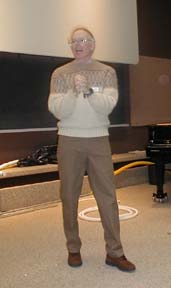
Hello I'm Paul Doherty
Welcome to Technorama and it's new exhibition on vibration.
Technorama lecture, March 23, 2000
Remo Besio, the director of Technorama invited me to give a 30 minute lecture at the opening of his new exhibition on mechanics and vibration. Here is a report on that lecture.
by Paul Doherty

Hello I'm Paul Doherty
Welcome to Technorama and it's new exhibition on
vibration.
Ringing Aluminum Rod
To begin, I hold a 1.5 meter long 1 cm diameter
aluminum rod at its middle then whack it on the end with a
hammer.
It rings out two notes.
The lower pitch note fades away while the high pitch note continues
to ring for over a minute.
I just stand there holding the rod which rings and rings and rings.
After 15 seconds the audience laughs.

Paul holds the ringing aluminum rod.
Sound is the organized motion of the rod.
The organized motion is converted into heat and the sound fades
away.
Aluminum rods turn the organized motion into disorganized motion very
slowly, they can ring for over a minute.
Fingers turn organized motion into heat.
I hold the rod at the middle and hit it on the end. It rings.
I grab the end between two fingers and the rod stops ringing
immediately.
I hit it again and grab it near the middle, it keeps ringing.
I grab it 1/4 of the way from the end and it stops ringing
slowly.
Your fingers tell you where the rod is vibrating.
If you grab it where it is vibrating, the sound goes away. the
greater the vibration the faster the sound goes away.
But the rod only rings if you hold it at special places like the middle.
Other special places are 1/4 of the way from one
end.
I hold the rod at this point and it swings down until it is
vertical.
Then it it and it rings with a higher pitch for nearly a minute.
After a while I hold it at 1/4 and 3/4, it continues to ring.
So the rod does not vibrate at the 1/4 and 3/4 marks.
I grab it in the middle and the sound dies away instantly.
We can find the invisible pattern of vibration with only our fingers
for tools.
It also rings if I hold it 1/6, and 1/8 of the way
from one end. I do that.
The rod rings when held at the 1/6 mark and at the middle.
It doesn't ring if you hold it at other points
like 1/3 of the way from one end.
I do that and it goes thunk.
So objects vibrate when you hit them, the frequency of the vibration depends on the pattern of vibration, or on where you hold it.
Remember that low note that died away when I held
the rod in the middle.
I have a demonstration to teach about that.
I pick up a 4 meter long 2 cm diameter tube of PVC. It sags a little at the ends.
I move my hand up and down and the rod begins to vibrate up and down a lot at the ends. This is the motion of the aluminum rod when it sings the lower pitch note.
Learning to Walk the Walk
However the explainers at the Exploratorium immediately saw another use for it.
They said that I walked like a physics professor. I walk across the stage.
I needed to walk with more rhythm and the tube could help me. I hold the rod in the middle and it wiggles up and down. I move to the rhythm of the rod.
Walking with rhythm, I am cool! (Well at least cooler than a physics professor!)
Playing the Slinky Accordion
To Visualize how the rod is vibrating in the high
pitch mode,
I slide an orange slinky onto a slippery plastic rod, PVC.
Then with the same grace that my host Remo used when he sat down at
the piano I sat down to play the slinky accordion.
Just like an accordion I move my hands together and apart, it is as if I am applauding myself.
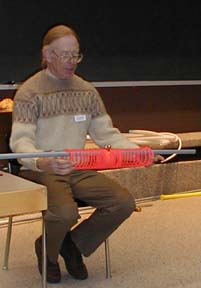
Paul shows the node at the center of a slinky in its
fundamental mode of oscillation.
I build up a rhythm and find the resonance.
I ask the audience to notice how the "slinks" move.(A slink is my
name for one turn of a slinky.)
The slinks do not move back-and-forth in the center of the
slinky.
However the coils crowd together at the center and then spread apart
there.
It is easy to see the alternating flash of orange and then dark as
the slinks crowd together and then spread apart.
It is harder to see that the middle slink doesn't move.
So I clip a yellow LED to a small 3 volt lithium
battery disk using a binder clip.
The battery and LED are inside an "electricity condom" cut from the
neck of a balloon. The lamp glows bright yellow and is visible
throughout the room.
The lamp doesn't move.
The lamp is at a node of motion.
It is also at an antinode of pressure, when the slinks crowd close
showing a flash of orange they are at high pressure, when they spread
apart, low pressure. The changes are greatest at the center. The
center is an antinode of pressure. The Swedish have a better word for
antinode "bök" which is the same name as the protruding stomach
of a beer drinker.
By moving my hands faster I can get three nodes on the slinky.
But I can't get two nodes at any frequency of hand motion.
I confess that this result puzzled me even with my Ph.D. from MIT I didn't know instantly how to get two nodes on the slinky. After some thought however I realized the answer:
The Bhudist clap, actually the double bhudist clap.
Which is the sound of one hand clapping done with both hands.
Both hands move right, then both move left at the
same time.
The hands stay the same distance apart.
The result is a pattern on the slinky with an even number of nodes.
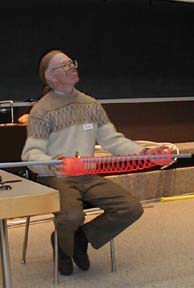
The Bhudist clap makes the second harmonic.
After the rod and the slinky I do four fast activities, just like commercials.
The first is:
Mass on a spring
How simple can you get?

A steel ball under my hand, hung from a spring.
I pull the mass down and let go.
It moves up and down at the resonant frequency of the
system.
As I point out that people should look for the
mass and the spring in all oscillating systems, the mass begins to go
up and down less and to go side to side a little. The side to side
increases until the mass doesn't go up and down at all, it is a
simple pendulum.
But then the pendulum starts to bob up and down and soon it is not
going side to side anymore, it is going up and down.
I tell the audience that any simple scientific statement needs an asterisk*
* It's more complicated than that.
This simple mass and spring shows how
complications lurk when you least expect them.
(An aside, The spring is a special spring designed to produce the
puzzling motion.)
The spinning spoon.
Here is an activity hat belongs in my friend Eric's book on Restaurant Science. If you really hate a restaurant and don't plan to go back, bend a spoon handle back over the bowl as shown below. Push it a little to one side.
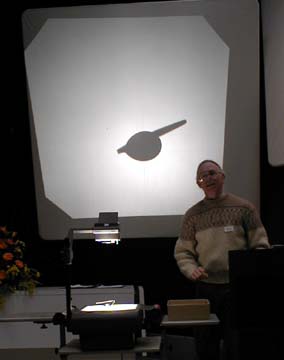
The bent spoon oscillator, notice the spoon on the overhead
projector.
Place the spoon on a convenient hard surface like
the top of an overhead projector.
Push the handle of the spoon down and let go.
The spoon will rock up and down, an oscillator.
But then, just like the mass and spring it will do something
different, it will begin to rotate.
Start it rotating the other way and the spoon will stop rotating and
begin vibrating then rotate the opposite way.
The spoon looks like it is violating the law of conservation of angular momentum, but it isn't.
Vibrating Balls
I pick up two balls about 6 cm in diameter. Hold them in each hand and click them together. They make a nice vibrating collision you can easily hear.
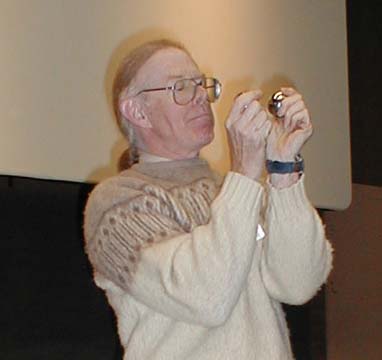
Paul clicks two steel ball bearings together.
The vibration of the two balls is identical, the impulse made when the balls smack together travels around the ball to the other side all arriving together making a large motion of the surface. The waves keep going, returning to the original point of contact. The waves travel around and around always adding together at the contact point.
On the moon when the seismic waves from the Imbrium basin crater rushed around to the other side, they all arrived together, their simultaneous arrival made the biggest moonquake in history throwing huge chunks of the surface of the moon into space jumbling the surface into a chaotic terrain.
We can use the same phenomenon too.
My wife Ellen came up from the audience to be my assistant.
She held a sheet of typing paper.
I clicked the balls together 5 times with the
paper between them.
Then showed the paper on the overhead projector.
Five ragged holes had been burned into the paper by the vibrating balls. Wow!
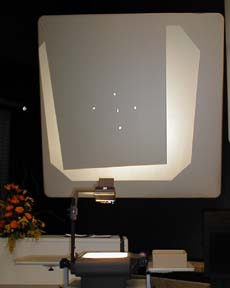
Vibrating ball bearings burn 5 holes into a sheet of typing
paper.
Vibrating Downer
My friend Engineer Lundström gave me an
interesting apparatus.
A piece of grooved aluminum, Bolt heads fit the grooves and are
attached to springs with a ball like mass on the end.
Start the balls at the top and they vibrate with a wonderful sound to
the bottom.
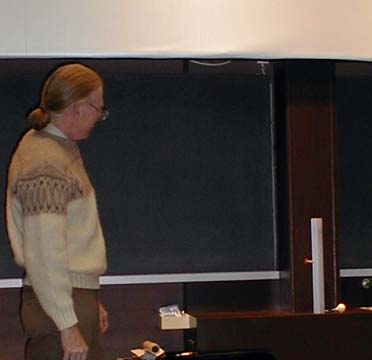
Balls vibrating in grooves noisily bounce their way down to the
bottom.
Then it was time for my finale:
Whirlies
I twirled the three foot long children's toy whirly playing a series of notes up and down the scale. "I fell in love with the sounds of the whirly the first time I heard one. Whirlies only play notes which sound good together. No matter how I swing it around, it only plays certain notes. It does not slide from note to note it jumps. It thus behaves like the electron in an atom which jumps between energy levels. The whirly plays quantum music.
After I had played the toy whirly for a while I got tired of the same five notes and began looking for other corrugated singing tubes. I conceived of a plan to incorporate the whirly into symphony orchestras. That set me on a search for the full range of instruments from alto to bass. My first experiments were geared toward finding bass instruments. One day, my wife Ellen and I were at a friend's swimming pool. In the pool I spotted a surface vacuum cleaner trailing a long flexible corrugated hose. Ellen impressed me with her speed as she stopped me from unfolding the blade of my knife. She talked me into waiting a day and buying my own hose from a swimming pool supply store. At the store I purchased my first swimming pool vacuum hose whirly.
I played a few notes and they rang out loud and clear in the room.

One day a professional whirly player came to the Exploratorium, Sarah Hopkins. She had a question for me, how do whirlies sing their songs.
I was pleased to be able to give her a short complete answer,"I don't know." She laughed and said that she had already asked two physicists and received two different answers.
I suggested we do some experiments. While we worked together Sarah tuned this whirly for me and taught me to play a piece of music she composed for it, "Deep Whirly Heartsong." I played it.
The performance whirly filled the hall with sound.
As the last note faded away the audience applauded and cheered.
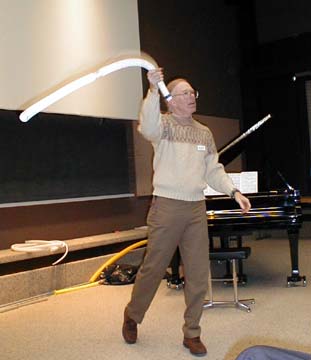
Paul playing "Deep Whirly Heartsong" by Sarah Hopkins.
We began to discover how whirlies work.
Note the lower pitch of the lowest note of the longer whirly. The
whirlies only sing sound waves which fit in them exactly, longer
tubes mean longer soundwaves which have lower pitch.
It got to the point where my wife hated to go into
hardware stores with me.
I kept blowing into and whirling every piece of corrugated hose I
could find; gas pipes, electrical conduit and electrical wire
guides... like these."
I picked up the two "Fly" whirlies.
"I was thrilled to find something to do with my left hand."
I began to play 'Fly' (another Sarah Hopkins composition.) by arcing
the two whirlies from above my shoulders down across the front of my
body.
"When I play this I find that even in the roughest neighborhoods no
one gets within several feet of me. This motion allowed me to combine
music, physics and self-defense!"
I segued into the second part of 'Fly' which involves swinging the
two whirlies alternately, then into the finish with arcing moves
again. The audience applauded.

Just like the Mr. Toad who was stricken with
automobile fever, I was smitten with whirlies. When I went to visit
friends they hid their china and lamps. The children loved me
though.
" One day a friend made the comment that my music was not very
multicultural. I took his words to heart."
I picked up a toy whirly attached to a 5 gallon plastic bag. I filled
the bag with air from a battery operated leaf blower. The audience
giggled at the sight of a turgid bag attached to a whirly, then
laughed aloud as I tucked the whirly under my arm and they figured
out what I was going to do. I played the bag whirly by squeezing the
bag under my arm.
I was pleased to find the answer to my search for multicultural
whirlies in with my own Celtic roots...
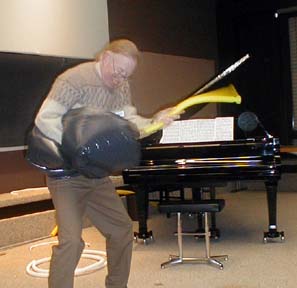
After I played half a bagful of notes, I removed the bag from my underarm and played the whirly in my usual swinging way. The whirly sang and sucked the remaining air from the bag. The singing stopped when the bag was empty. I looked quizzically at the quiet whirly and its deflated bag and said, of course, "pardon me but my instrument seems to be a little flat tonight." (This time the audience groaned.)

Whirly discoveries came fast and furious.
I found my highest pitched instrument in a 7-11."
I pick up a large plastic cup pull out the corrugated straw and blow
a few notes making high pitched sounds.
"Have you ever been thrown out of a 7-11?"
"I have."
I still longed for deeper notes.
Then one day at a winery my attention was riveted by a piece of
hosing. My wife shouted "NO!" But she was too late I had found the
Mount Everest of whirlies &emdash; agricultural drain hose. It was
three inches in diameter and twelve feet long."
I picked up my giant whirly and held it, coiled around me on the
stage looking at it in a perplexed way.
The only problem was how could I play it?
Then I started to spin A loud low tone grew to fill the room. I spun
faster, a higher bass note rang out, faster and faster&emdash; the
whirly sang higher notes. I slowed down slowly, dropping from one
note to the next until I ended by holding the lowest note for a few
seconds before brining the whirly to a gentle landing on the stage
coiled at my feet.
I ended facing the audience.
The room erupted with cheers and applause.
WOW.
I sure had fun at this lecture.
We then went in to see the new exhibition on vibration and I realized that the fun had just begun. Remo had put together an excellent exhibition.